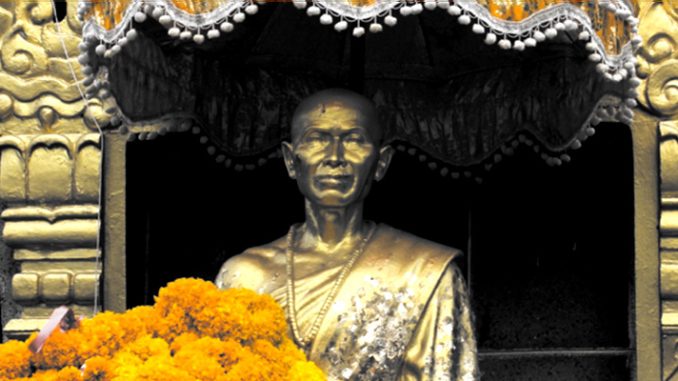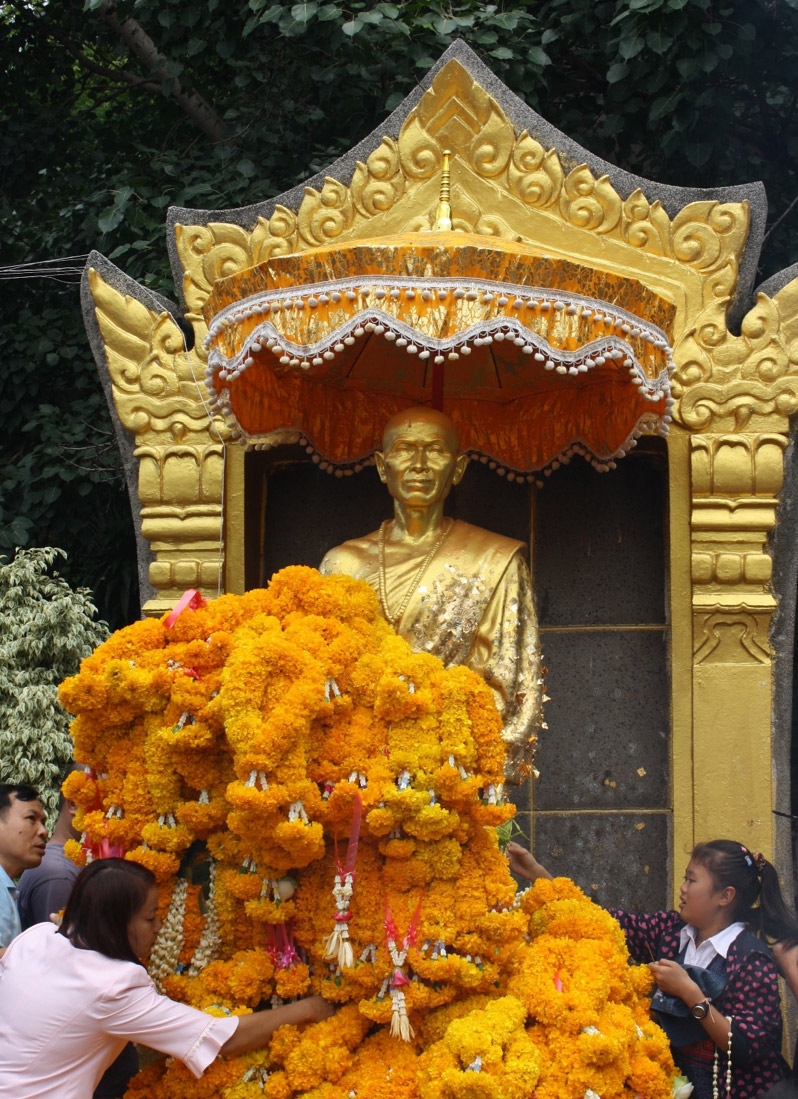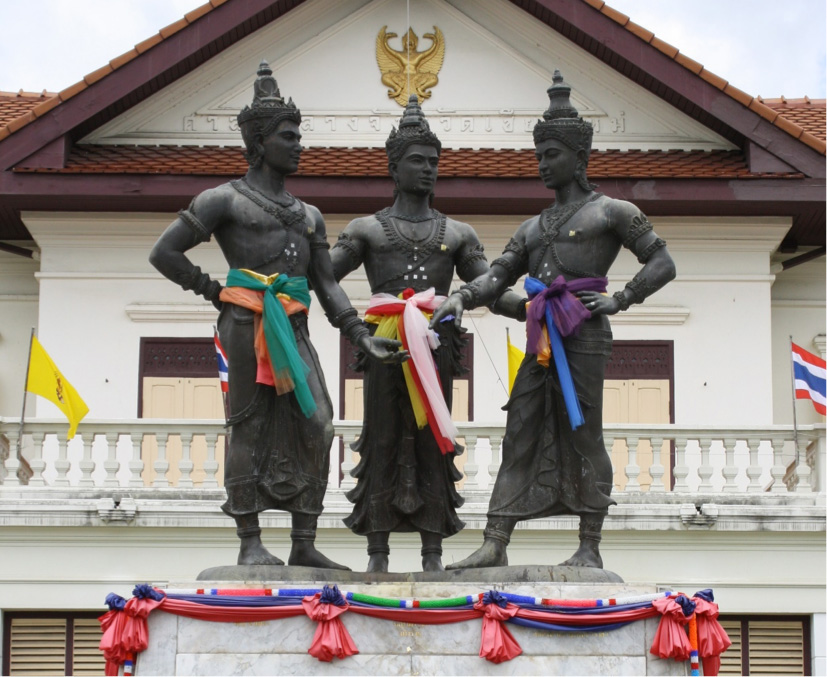
Monuments and statues have long been popular among states seeking to define collective memory. Such obsession with statuary commemoration has even been described by some as a sort of ‘statuemania’, an ailment of national elites and urban planners not only in the west, but also in places like Thailand, where new monuments began to dot the urban landscape of Bangkok in the early twentieth century. 1 In many ways this mania continues to spread – and grow – with the construction of Ratchapakdi Park in Hua Hin, Thailand, described recently as “a theme park with monuments to seven kings enshrined by the military government.” 2
This fascination with statuary monuments extends beyond the present, beyond the center, and beyond the state. The military junta’s historical fantasyland of Ratchapakdi is only the latest manifestation of a long history of royal monumentalization in Thailand. Likewise, the urban transformation of Bangkok during the twilight of the absolute monarchy was just one setting for statuemania; in the northern city of Chiang Mai, for example, historical monuments point not only to key moments in the history of the city and the region, but more importantly to local variations on the state’s attempt to impose the dominant royalist-nationalist historical theme on local memory. 3 Finally, statuemania is not an ailment suffered exclusively by a monolithic state actor; rather, it is a shared condition with diverse actors and interests. While individual artists sculpt and cast the statues themselves, national and local elites also work to shape the popular memory expressed through these “immobile memories.” 4
Khruba Sriwichai
One of the earliest modern statuary monuments erected in Chiang Mai was dedicated to Khruba Sriwichai (1878-1938), a charismatic monk best known for his resistance to Bangkok policies of military conscription, his ambitious career of temple restoration, and his construction of a road from the edge of the city to the mountain-top temple on Doi Suthep, all of which made him something of a thorn in the side of Bangkok authorities. 5
The push to construct a monument to Khruba Sriwichai started locally, particularly with the first MP for Chiang Mai, Luang Sri Prakad. The archival record amply documents his enthusiasm for the monument, and his efforts to promote it within the government and to install it at the foot of Doi Suthep. 6 At first glance, it might seem surprising to find a monument to such a troublesome figure for Bangkok supported so strongly by the central state. Though it might be too simplistic to suggest that this statue is part of a broader move towards acknowledging provincial diversity, 7 the monument certainly has become a focal point for “locally or regionally based discourses.” 8 In responding to local initiative, Bangkok was attempting to incorporate the legacy of this charismatic and problematic monk. This was not the first effort in this regard. For instance, in 1946 the Thai monarchy sponsored an official cremation, after which his remains were divided in six portions and distributed around the provinces of the north. 9 At the time of his death in 1938, he remained a symbol of northern identity that was at best different, and at worst in opposition to that of Bangkok-dominated Siamese/Thai national identity. When the monument was installed in 1956, only 18 years later, personal memory was still salient to the creation and reception of this monument. The monument to Sriwichai may have sought to ‘tame’ the memory of the problematic monk by transferring some of his charisma to the central state, but it also remained open to local discourses of memory.

The Thai state shaped this memory through the work of the sculptor Silpa Bhirasri. 10 A naturalized Thai citizen originally from Florence, Italy, Silpa was later considered the father of modern Thai art, as well as Prime Minister Phibun Songkhram’s chief statuary propagandist. It was during the Phibun era, Maurizio Peleggi writes, that statuary monuments were “deployed as a vehicle of political propaganda.” 11 Silpa produced notable statues in Bangkok, such as the Taksin equestrian monument, and he designed one of the most famous monuments in Bangkok, the Democracy Monument. 12 He also trained other sculptors, including Khiem Yimsiri, who assisted him with sculpting and casting the Sriwichai statue, and Khaimuk Chuto, who would create the most well-known monument in Chiang Mai 27 years later – the Three Kings Monument.
Three Kings
The most popular—and popularly reproduced—monument in Chiang Mai is located in its center and consists of three royal figures: Phya Mangrai, Phya Ngam Muang, and Phya Ruang, more commonly known as Ramkhamhaeng, a thirteenth century king from Sukhothai, and the progenitor of the notion of benevolent kingship in Thai history. 13 The monument tells the story of the founding of the city in 1296, when these three met to determine the location, layout, and size of Mangrai’s new city, which was to serve as the capital of his new kingdom of Lanna.
The monument had a complicated genesis, and actually began as a local movement to erect a monument to Mangrai alone. 14 In 1969, the local committee formed to facilitate efforts to commemorate Mangrai contacted the Fine Arts Department (FAD) to arrange for the design of the monument, and the minister of education, Sukit Nimmanhemin, to secure the land and the support of the FAD. In the summer of 1969, at the minister’s suggestion, the FAD transformed the notion of a monument to Mangrai into a monument to three kings. Why? As the government explained one year later, the proliferation of statuary monuments had the potential to cause ‘confusion’—meaning create historical memory not approved by Bangkok. In March 1970 the government announced a new policy: any plans for monuments or memorials to important figures had to be submitted to the government for consideration. 15 The problem of provincial statuemania had become a concern at the highest levels of government. Nevertheless, the question of the change from one to three kings continued to gain interest. On June 5th, the local newspaper asked “Monument to Mangrai: Are One or Three Kings Better?” The governor of Chiang Mai complained that inclusion of the other kings would lessen the importance of Mangrai, and that it would require additional explanation, particularly for the younger generation. 16 The local descendants of the old Chiang Mai monarchy likely preferred a monument to Mangrai alone as well. 17

Once Ngam Muang and Ramkhamhaeng had been added, the question of the monument’s composition produced more controversy. Mangrai stands at the center, but it is Ramkhamhaeng who is authoritatively centered, as the one to whom the others are listening. 18 While some locals expressed dissatisfaction with the narrative de-centering of Mangrai, others asked why Ramkhamhaeng was not more central, since, from a national perspective, he was naturally to be considered more important. 19 Ramkhamhaeng and Mangrai competed for top billing in a variety of ways—for example, when commemorative amulets were issued in connection with the opening of the monument, Ramkhamhaeng’s name was listed first, before Mangrai’s. 20 The design of the figures is also telling. The sculptor, Khaimuk Chuto, a relative of the Thai queen, conceived of the facial expressions of the kings as reflections of their personalities: Mangrai is beautiful, Ramkhamhaeng is a ruler, and Ngam Muang is “handsome and flirtatious”. 21
Perhaps from Bangkok’s perspective, the dual-centering of Mangrai and Ramkhamhaeng was a compromise. From the perspective of Chiang Mai, however, this was an imposition of national history over local memory. By expanding the tableau from one king to three, this monument recentered historical discourse according to the dictates of the Bangkok state, tethering the history of Chiang Mai to that of Bangkok.
Statuary Embodiments
These statues exist not only as secular monuments, but as objects of religious devotion and ritual as well. Indeed, the lines between secular and religious statues are blurred in much of Southeast Asia. Statuary monuments to Bangkok kings or other figures can easily become focal points of worship and ritual, and there are many realistic images of monks installed in local museums as well as temples. 22 After completion, the statues of the three kings entered Chiang Mai in the same manner as ancient kings, moving through Chang Phuak gate in the north of the city, before proceeding to the sacred space in the city center. These statues moved as if they were kings, and today are venerated as embodiments of ancestral royal power. The monument continues to be reinterpreted by competing groups laying claim to the magico-religious power of the city center in the face of Bangkok’s dominance. 23
Likewise, the Khruba Sriwichai monument embodies both religious and secular memory. In 1972, for example, Wat Sri Soda, a temple located near the base of the road Sriwichai and his followers built up the mountainside, asked for the statue to be relocated within temple grounds. In effect, they made a claim on the statue as a religious image, arguing that they would be better able to protect the statue and make rituals of merit-making more convenient. An op-ed published in the local Khon Muang newspaper strongly countered the plan, arguing that it was simply a cash grab, and that the original location was chosen so that the statue could be widely seen, and thus help people to remember (ramlukthung) the good deeds of this venerable monk. 24 Today, the monument remains at the original site as a focal point of both remembrance and veneration.
Conclusion
All monuments distort collective memory to some extent. The monuments considered above are just two sites among many where historical memory is given shape and form in Chiang Mai today. The controversies surrounding the Three Kings, or the brief plan to relocate the Khruba Sriwichai monument, should not be forgotten; still, once controversial images can also be redeployed as symbols of local identity. The silhouette of the three kings can be used to mark anything as northern, Lanna, or Chiang Mai—if New York has the Statue of Liberty, then Chiang Mai has the three kings. Just as artists sculpt these statues, social and political forces shape the landscape of memory. Examining “statuemania” from a regional perspective, however, reveals how specific political limits on the embodiment of local memory can produce statues like those at Ratchapakdi Park: blunt instruments of a military-approved hyper-royalist and ultra-nationalist version of Thai identity and history.
Taylor M. Easum
(Assistant Professor of History, University of Wisconsin, Stevens Point)
Issue 20, Kyoto Review of Southeast Asia, September 2016
Bibliography
Published Materials:
Agulhon, Maurice. “La « Statuomanie » et L’histoire.” Ethnologie Française 8, no. 2/3 (1978): 145–72.
Bowie, Katherine A. “Of Buddhism and Militarism in Northern Thailand: Solving the Puzzle of the Saint Khruubaa Srivichai.” The Journal of Asian Studies 73, no. 3 (August 2014): 711–732.
Doss, Erika. Memorial Mania: Public Feeling in America. University of Chicago Press, 2012.
Easum, Taylor M. “A Thorn in Bangkok’s Side Khruba Sriwichai, Sacred Space and the Last Stand of the Pre-Modern Chiang Mai State.” South East Asia Research 21, no. 2 (June 1, 2013): 211–36.
Evans, Grant. “Immobile Memories: Statues in Thailand and Laos.” In Cultural Crisis and Social Memory: Modernity and Identity in Thailand and Laos, edited by Shigeharu Tanabe and Charles F Keyes, 154–82. Honolulu: University of Hawaiʻi Press, 2002.
Johnson, Andrew. “Re-Centreing the City: Spirits, Local Wisdom, and Urban Design at the Three Kings Monument of Chiang Mai.” Journal of Southeast Asian Studies 42, no. 3 (2011): 511–31.
Khaimuk Chuto. Chiwit lae ngan khong Khaimuk Chūtō [The Life and Work of Khaimuk Chuto]. Bangkok: Kō̜ng Sinlapāchīp, Samnak Rātchalēkhāthikān, 1997.
Kongpob Areerat. “Thai Junta Coins New History Book to Legitimise Its Rule.” Prachatai English. Accessed October 31, 2015. http://www.prachatai.com/english/node/5576.
Kwok Kian-Woon, and Roxana Waterson. “The Work of Memory and the Unfinished Past: Deepening and Widening the Study of Memory in Southeast Asia.” In Contestations of Memory in Southeast Asia. Singapore: NUS Press Pte Ltd., 2012.
Lanna Thai: Anuson Phraratchaphithipoet Phraborommarachanusaowari Sam Kasat (Chiangmai 2526-27) [Lanna Thai: Memorial for the Opening of the Three Kings Monument (Chiang Mai, 1983-84)]. Chiang Mai: Khanakammakan chat tham nangsu, 1984.
Malinee Khumsupa. Anusawari Prachathippatai kap khwammai thi mong mai hen [The Democracy Monument and Its Hidden Meanings]. Krung Thēp: Wiphāsā, 2005.
Mukhom Wongthes. Intellectual Might and National Myth: A Forensic Investigation of the Ram Khamhaeng Controversy in Thai Society. Bangkok, Thailand: Matichon Public Co., 2003.
Peleggi, Maurizio. Lords of Things: The Fashioning of the Siamese Monarchy’s Modern Image. Honolulu: University of Hawaiʻi Press, 2002.
Rhum, Michael R. “The Future of the Past in Northern Thailand.” In Southeast Asian Tribal Groups and Ethnic Minorities: Prospects for the Eighties and Beyond, 117–24. Cambridge: Cultural Survival, Inc., 1987.
Stengs, Irene. Worshipping the Great Moderniser: King Chulalongkorn, Patron Saint of the Thai Middle Class. Seattle: University of Washington Press, 2009.
Tannenbaum, Nicola. “Monuments and Memory: Phaya Sihanatraja and the Founding of Maehongson.” In Cultural Crisis and Social Memory: Modernity and Identity in Thailand and Laos, edited by Shigeharu Tanabe and Charles F. Keyes, 154–82. Honolulu: University of Hawaiʻi Press, 2002.
Terwiel, B. J. The Ram Khamhaeng inscription: the fake that did not come true. Gossenberg: Ostasien Verlag, 2010.
Thongchai Winichakul. “The Changing Landscape of the Past: New Histories in Thailand since 1973.” Journal of Southeast Asian Studies 26, no. 1 (March 1995).
Viboon Leesuwan. Chiwit ae Ngan Khong Achan Sin Phirasi [The life and works of Silpa Bhirasri]. Bangkok: SITCA Investment & Securities Public Co., 1996.
Wong, Ka F. Visions of a Nation: Public Monuments in Twentieth-Century Thailand. Studies in Contemporary Thailand 15. Bangkok: White Lotus, 2006.
Newspapers:
Khon Muang Newspaper, (1969-1972).
Notes:
- Evans, “Immobile Memories: Statues in Thailand and Laos”; Tannenbaum, “Monuments and Memory: Phaya Sihanatraja and the Founding of Maehongson”; Agulhon, “La « Statuomanie » et L’histoire.” ↩
- Kongpob Areerat, “Thai Junta Coins New History Book to Legitimise Its Rule.” ↩
- Thongchai Winichakul, “The Changing Landscape of the Past.” ↩
- Thongchai Winichakul, “The Changing Landscape of the Past.” ↩
- Bowie, “Of Buddhism and Militarism in Northern Thailand”; Easum, “A Thorn in Bangkok’s Side Khruba Sriwichai, Sacred Space and the Last Stand of the Pre-Modern Chiang Mai State.” ↩
- 4) ศธ 2.2.3.1/11, Kansāng ‘anusāwarī Phra Sīwichai phua nampai praditsathān na boriwēn senthāng khun sū Doi Suthēp čhangwat Chīang Mai(1956-63), National Archives of Thailand, Bangkok, Records of the Ministry of Education, 1962. ↩
- Wong, Visions of a Nation. ↩
- Evans, “Immobile Memories: Statues in Thailand and Laos,” 177. ↩
- Easum, “A Thorn in Bangkok’s Side Khruba Sriwichai, Sacred Space and the Last Stand of the Pre-Modern Chiang Mai State,” 234. ↩
- Viboon Leesuwan, Chīwit Læ Ngān Khō̜ng Āčhān Sin Phīrasī. ↩
- Peleggi, Lords of Things, 102, 194. ↩
- [1] Malinee Khumsupa, Anusāwarī Prachāthippatai kap khwāmmāi thī mō̜ng mai hēn [The Democracy Monument and Its Hidden Meanings]. ↩
- Mukhom Wongthes, Intellectual Might and National Myth; Terwiel, The Ram Khamhaeng inscription. ↩
- Khon Muang, 10 June 1969. ↩
- Khon Muang, 25 March 1970. ↩
- Khon Muang, 5 June 1970. ↩
- Rhum, “The Future of the Past in Northern Thailand.” ↩
- Johnson, “Re-Centreing the City.” ↩
- Lanna Thai. ↩
- Rhum, “The Future of the Past in Northern Thailand.” ↩
- Lanna Thai, 60. ↩
- Evans, “Immobile Memories: Statues in Thailand and Laos,” 168–70; Johnson, “Re-Centreing the City”; Stengs, Worshipping the Great Moderniser. ↩
- Johnson, “Re-Centreing the City.” ↩
- “Where should the Khruba Sriwichai monument be placed?” Khon Muang, 20 June 1972. ↩
